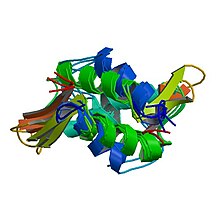Histone H1: Difference between revisions
categorization/tagging using AWB |
Move notice |
||
| Line 1: | Line 1: | ||
{{movenotice|Linker histone}} |
|||
{{Pfam_box |
{{Pfam_box |
||
| Symbol = Linker_histone |
| Symbol = Linker_histone |
||
Revision as of 10:54, 9 September 2010
A request that this article title be changed to Linker histone is under discussion. Please do not move this article until the discussion is closed. |
| linker histone H1 and H5 family | |||||||||||
|---|---|---|---|---|---|---|---|---|---|---|---|
 | |||||||||||
| Identifiers | |||||||||||
| Symbol | Linker_histone | ||||||||||
| Pfam | PF00538 | ||||||||||
| InterPro | IPR005818 | ||||||||||
| SMART | SM00526 | ||||||||||
| SCOP2 | 1hst / SCOPe / SUPFAM | ||||||||||
| |||||||||||
Histone H1 is one of the 5 main histone protein families which are components of chromatin in eukaryotic cells, and is the most variable histone in sequence across species. A variant of the histone H1 protein is the histone H5, which has a similar structure and function, but is only found in avian erythrocytes, which unlike mammalian erythrocytes, have nuclei.

Featuring a central globular domain and long C- and N-terminal tails, H1 is involved with the packing of the "beads on a string" sub-structures into a high order structure, whose details have not yet been solved [1]
H1 is present in half the amount of the other four histones. This is because unlike the other histones, H1 does not make up the nucleosome "bead". Instead, it sits on top of the structure, keeping in place the DNA that has wrapped around the nucleosome. Specifically, the H1 protein binds to the "linker DNA" (approximately 80 nucleotides in length) region between the histone beads, helping stabilize the zig-zagged 30 nm chromatin fiber.[2]
H1 histone seals off the nucleosome at the location at which the linker DNA enters and leaves.
See also
- nucleosome
- histone
- chromatin.
- Other histone proteins involved in chromatin:
References
- ^ Ramakrishnan V, Finch JT, Graziano V, Lee PL, Sweet RM (1993). "Crystal structure of globular domain of histone H5 and its implications for nucleosome binding". Nature. 362 (6417): 219–23. doi:10.1038/362219a0. PMID 8384699.
{{cite journal}}: Unknown parameter|month=ignored (help)CS1 maint: multiple names: authors list (link) - ^ Jeon, Kwang W.; Berezney, Ronald (1995). Structural and functional organization of the nuclear matrix. Boston: Academic Press. pp. 214–7. ISBN 0-12-364565-4.
{{cite book}}: CS1 maint: multiple names: authors list (link)
This article has not been added to any content categories. Please help out by adding categories to it so that it can be listed with similar articles, in addition to a stub category. (August 2010) |
